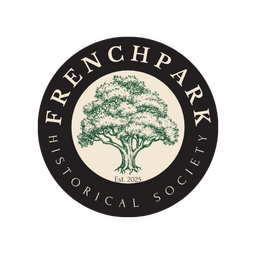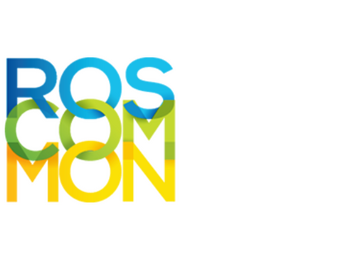Frenchpark Historical Society Presents:
The Living Thread
of
Dún Gar
An Online Heritage Mural
For thousands of years, this place has been home to many: warriors and saints, herders and healers, makers and rulers, reformers and visionaries — people of unyielding strength, their lives woven into its story.
This online heritage mural is a telling of that story: an effort to explore Frenchpark’s foundations and bring to light the people, events, and landscapes that shaped it.
It is part of a growing commitment to ensure that our heritage, more vibrant than many realise, is not only documented and preserved, but celebrated.
The Living Thread of Dún Gar follows an unbroken line through six windows into Frenchpark’s past, from ancient myth to the dawn of the 20th century. This digital mural unfolds as a continuous procession — a single line carrying our history through time.
Scroll down or click below to
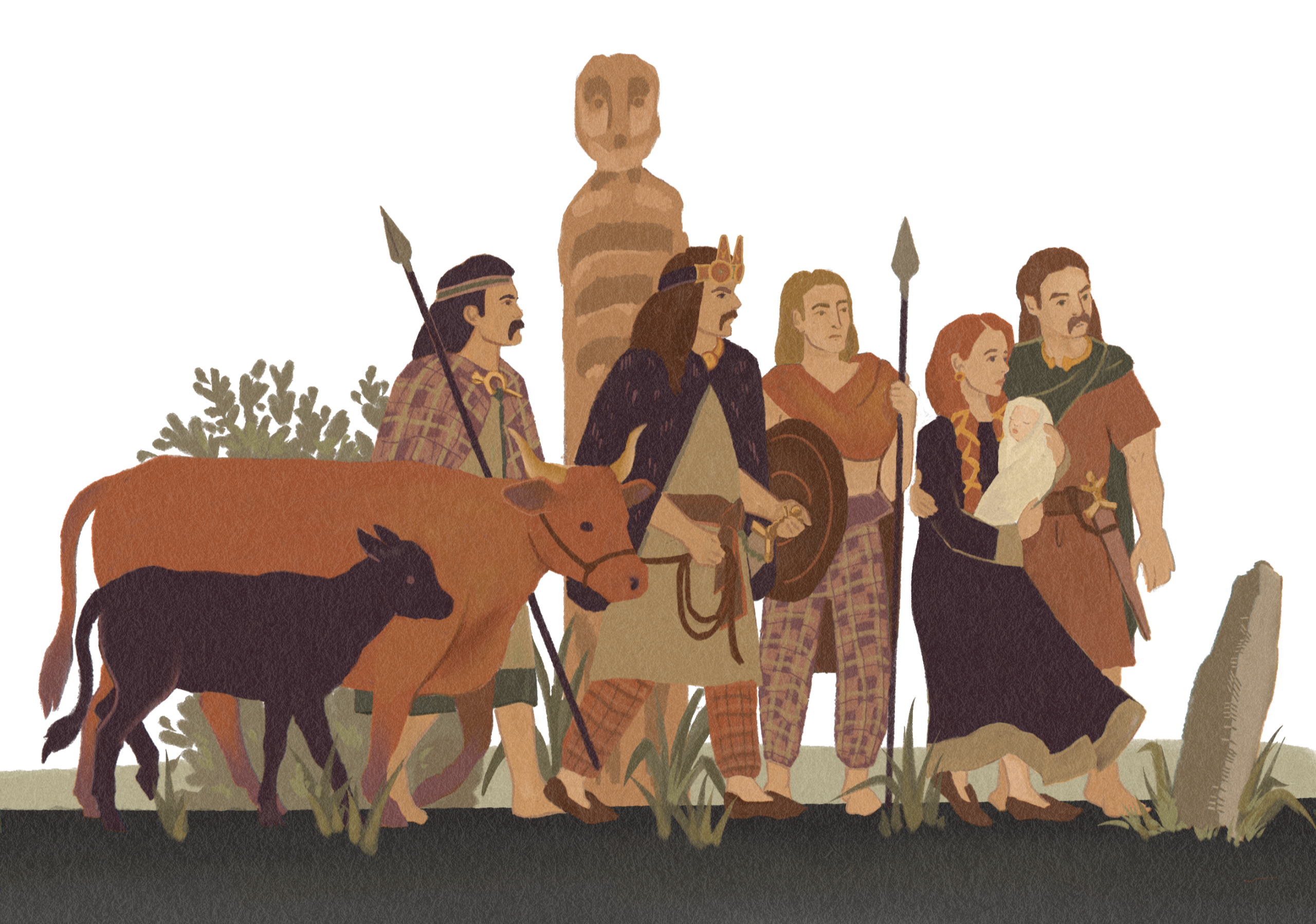
Airtech: Life, Legend & Legacy
Prehistory to 4th Century
The area around Frenchpark, long before it bore that name, is rooted in an ancient past spanning thousands of years. Though the record is fragmentary, archaeological evidence shows continuous human activity here since at least the Bronze Age, including fulachtaí fia (ancient cooking sites), burn mounds, cairns, standing stones, and even a five-chambered cave—possibly a souterrain—linked in local tradition to druidic use.Before Christianity, this land was known as Airtech, roughly corresponding to the modern Barony of Frenchpark, populated by tribes known as the Ciarraige Airtech. Medieval literature places Airtech as the site of the final battle after the Táin Bó Cúailnge, tying the ground beneath us to both historical society and the legendary cattle wars that shaped Ireland’s earliest stories.From these legends, we can deduce the central importance of cattle to early Gaelic clans. In the Iron Age, cattle were the foundation of wealth, power, and status, with early Irish law recording fines, alliances, and agreements in their value. The Ciarraige Airtech were certainly a part of this culture. Yet cattle alone did not define this world. Archaeological evidence—such as ancient toghers —together with the natural heritage of the region indicates that Airtech was dominated by marshland and bog. In early belief, such landscapes were liminal zones between the realm of the living and the Otherworld, and they often received ritual offerings or carved idols. Within the broader landscape, and in close proximity to Rathcroghan, Airtech likely shared in this ritual significance, its marshy landscape possibly serving as places of worship or communion with ancient deities.One of the first local figures to emerge into the historical record is Éanna of Airtigh (variant), a Gaelic chieftain of the Ciarraige . Early hagiography records him granting land to and his firstborn son in fosterage to St. Patrick. Éanna’s gift set in motion events that would lead to the foundation of Cluain Seanmhaol (Cloonshanville), shaping the region’s history for centuries to come.
Artist Notes: This scene depicts several thousand years in to one tight scene. Gaelic clans and nods to mythology are woven in to the first three characters. The Chieftain holds the rope to the cow, symbolising power. A likeness of the Gortnacrannagh Bog Idol stands solemnly behind as a testament to the marshy, otherworldly space this would have been to the ancients. To the right is Eanna of Airtigh, with his wife and new born son. They look off, towards the future, towards Christianity. His wife is hesitant, but windswept, representing the cultural force taking place. At the far right is a standing stone, with Ogham reading bottom to top 'Eanna Airtigh'. Among all these figures are depictions of Iron Age artefacts held by The National Museum. All details of their costume, while taking artistic liberties with colours, are taken from contemporary descriptions and surviving examples of Celtic (including Gaulish) textiles.
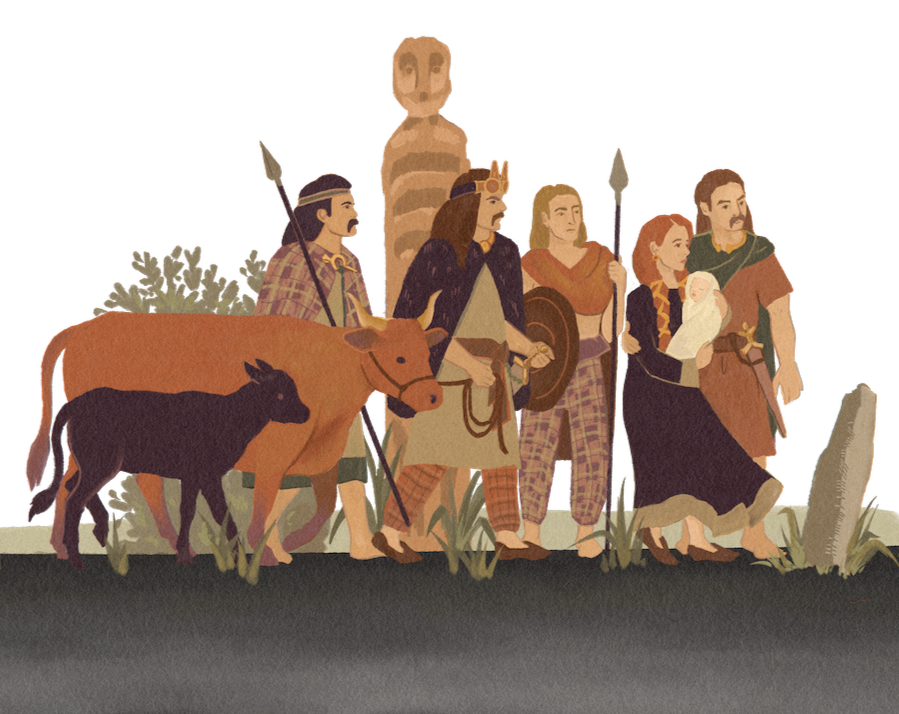
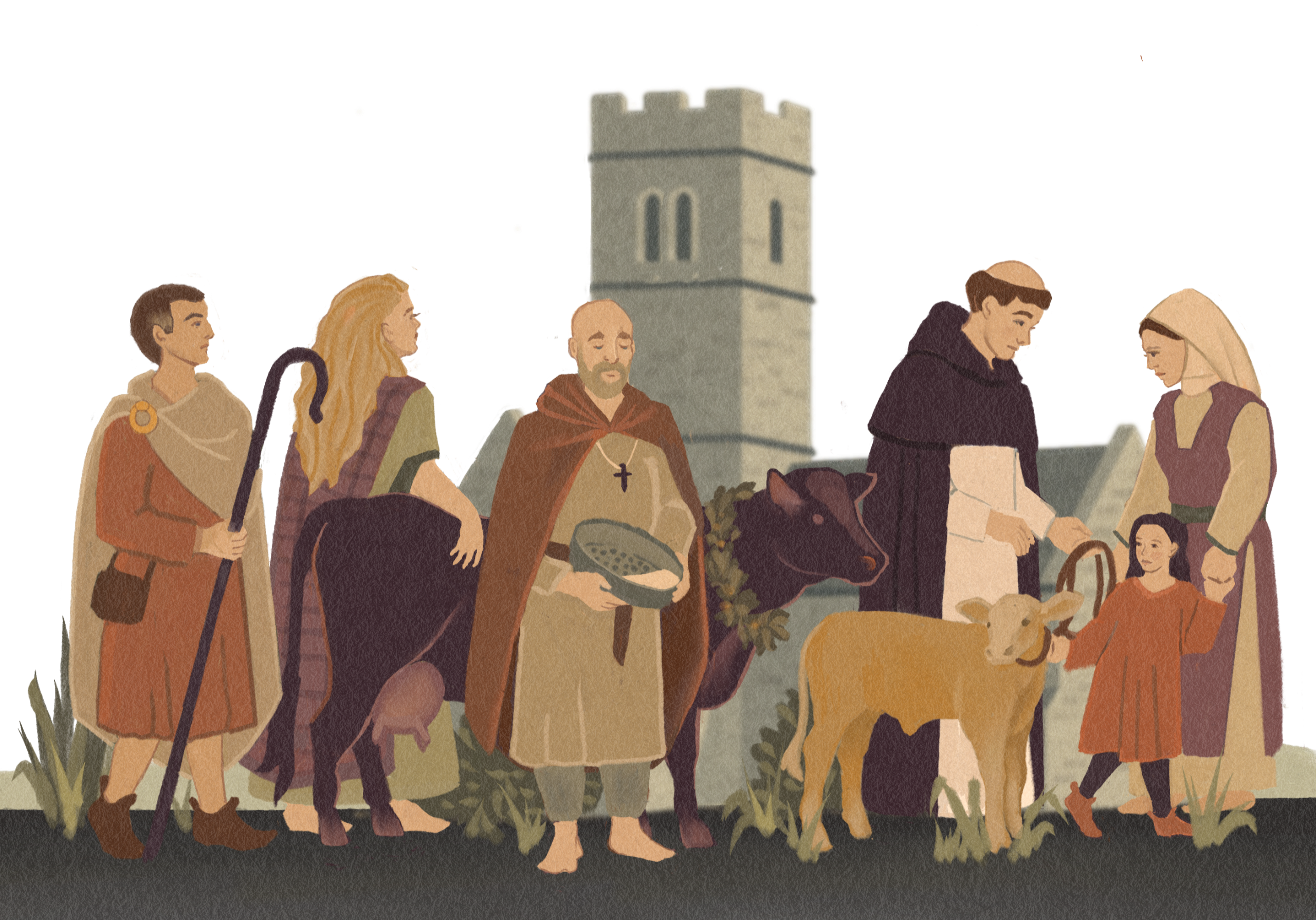
Saints, Scholars and Holy Cattle
4th to 14th Century
With Éanna's gift of land and the fosterage of his son Cormac, Patrick installed four bishops in Airtech—among them Bishop Connedus at Cluain Seanmhaol. Patrick charged these local bishops with the education of Cormac, and later accounts claim he became Patrick’s successor as Bishop of Armagh. Whether or not this is true, the existence of such a tradition underlines Airtech’s perceived importance, likely due to its proximity to the royal complex at Rathcroghan.For centuries, these churches were said to send a cow to Armagh every All Saints’ Day—a tribute linking Airtech to the primatial see. In early medieval Ireland, cattle were still the main measure of wealth, and many clergy were drawn from local dynasties, themselves warriors, landholders, and cattle-owners. Local tradition preserves other bovine links: a tale of a hermit’s cow that miraculously filled a sieve with milk, said to have been commemorated by a stone cow atop Cloonshanville’s tower.
By 1385, the Dominican Priory of the Holy Cross was founded at Cloonshanville. While the MacDermot Gall controlled the surrounding lands, there is evidence that the MacDermot Roe—hereditary Biatachs General of Connacht—were the patrons. Dominican life in the 1400s centred on preaching, teaching, and service to the local area. Travellers and the poor would have been fed and sheltered, aligning closely with the Biatach’s duty of public welfare.Whether established by the Roe or the Gall, the priory stood within MacDermot Gall lands and reflected the intertwined religious and political life of the district. By the late medieval period, Airtech’s history would increasingly be defined not only by its sacred institutions, but by its position on a volatile frontier—setting the stage for the fortifications and conflicts of the 16th century.
Artists Notes: Far right we see a representation of the earliest Christians. He is depicted be what St. Patrick most likely looked like - more Roman-British, wearing typical colours at the time such as madder red. He would have sported a simple shepherds crook or staff, and rustic, homespun wear. He could, however, also be Connedus here, first bishop of Cloonshanville.Next to him is the story of the blessed cow of Cloonshanville. The story tells of a holy man or hermit living in the bog where the Abbey now stands. A witch lived near and loathed him. He had an old cow who still gave milk, so at night she would transport herself to milk the cow dry. The hermit would wake to find the cow dry, but yet the cow came to him and asked to be milked with a sieve - he did so, and by a miracle did he milk the cow in full, and not a drop of milk spilled through the sieve. Here is that 'witch' and hermit. The story further says that the old hornless cow (maol) went on to be etched in stone on the abbey tower when it was built. To this day there is a cows head - and the name, Cloonshanville, is possibly a translation of 'Meadow of the Old Bald One' or, in this case, Hornless Cow. The story is likely a reflection of the struggle between Christianity and paganism.
To the far left is the Dominican Friar representing the Abbey and what it meant for this area - he is seen giving a calf to a poor woman and child - a small livelihood. In the back looms the abbey as it perhaps once looked.

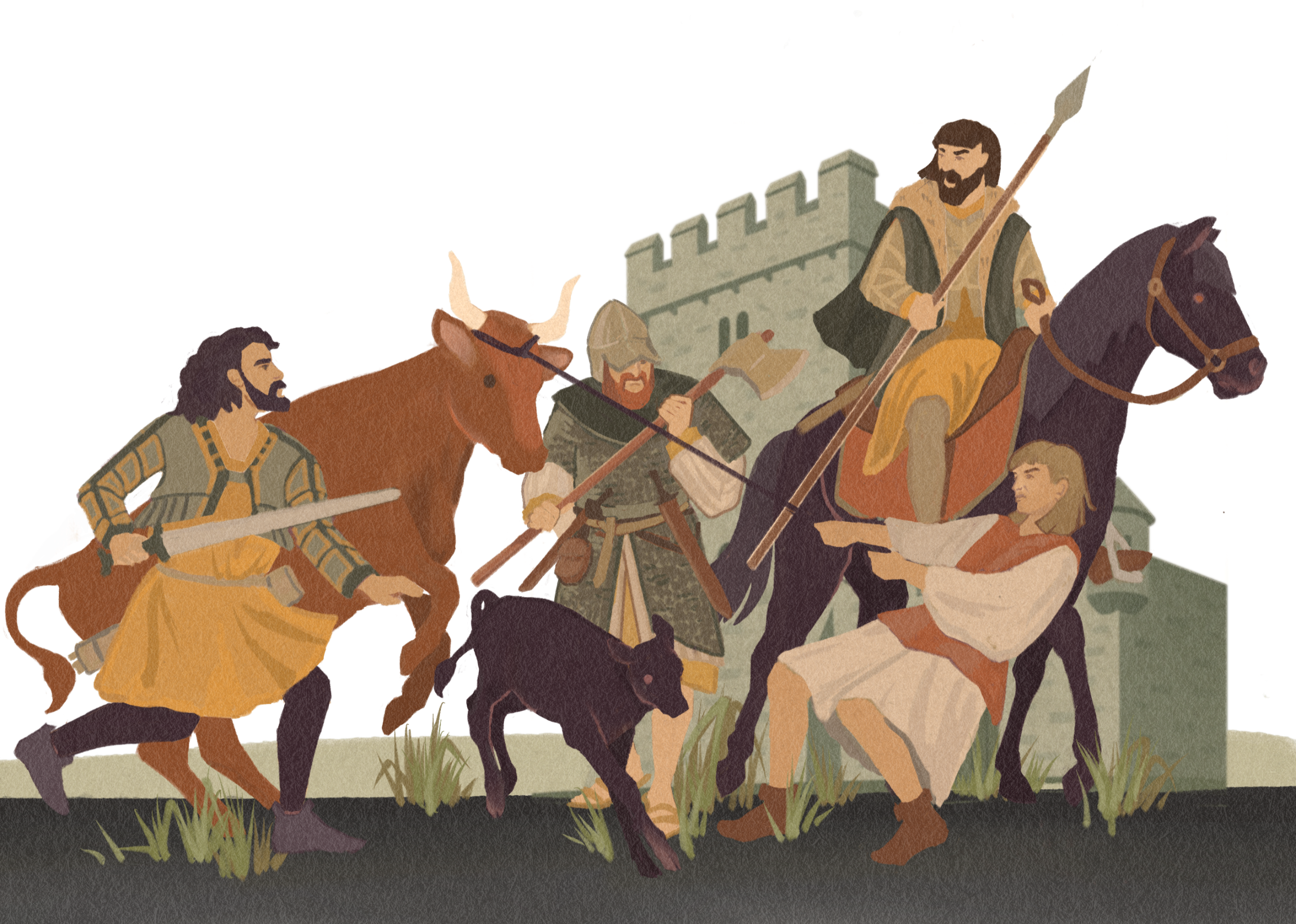
Castles, Clans, & Conquest
14th to 17th Century
From at least the early 14th century until the Cromwellian confiscations of the 1650s, the lands around modern Frenchpark—still known then as Airtech—were held by the MacDermot Gall branch of the Mac Diarmada dynasty, descended from Dermot Gall (“the foreigner”), a great-grandson of the king of Moylurg. The name Dún Gar appears in this period, situated near the Moylurg border and along the main route toward MacCostello territory—a natural strategic point controlling movement between the two lordships.The annals also record internecine warfare in 1346 between the MacDermot Gall and the senior MacDermot line, a reminder that Airtech’s defences were tested as much by kinsmen as by neighbours.
In 1565, Brian MacDermot, son of Ruaidhri, chief of Moylurg, secured the consent of the MacDermot Gall to build a fortified residence here. Within a few years, a major war engulfed Airtech and its neighbours, involving Gaelic clans, English forces, and Scottish gallowglass mercenaries. The Annals of Loch Cé record that the districts were “entirely wasted,” their people driven into surrounding territories.
Despite this devastation, Brian later resumed construction, adding a bawn (walled enclosure) at Dún Gar alongside major works at the Rock of Lough Key and the Monastery of the Trinity. Though not chief at the time, he maintained a courtly household, sponsored religious and literary figures, and remained a central player in regional power struggles. In 1585 he was inaugurated as chief of Moylurg, holding the title until his death in 1592.
After centuries of MacDermot Gall defence against rival lords, large-scale cattle raids, and internal clan disputes, the sept faded from prominence in the early 17th century. The Cromwellian land seizures brought the rule of Gaelic clans in the area to a close: Airtech lands were acquired first by the Dillon family and later the Frenches. The fortifications at Dún Gar disappeared from the landscape, and the landlord estate era began.
Artist Notes This scene captures the turbulence of late medieval Gaelic life, when inter-clan rivalries and cattle raids were constant features of the landscape. On the right is Brian MacDermot, mounted on horseback—an unmistakable mark of his high status as heir and future chief. He wears a brightly dyed saffron léine, a garment closely associated with Gaelic nobility, and fur cloak.To his left stands a heavily armed gallowglass mercenary, clad in mail and bearing a great axe. While no direct record survives of gallowglass stationed at Dún Gar, their widespread employment in broader area during this period, combined with Brian’s construction of a fortified stone castle, makes their presence here highly probable.On the far left, a clansman brandishes a sword while wearing a shorter coat over his léine. Swords were expensive prestige weapons, typically restricted to wealthier clansmen—most would have fought with spears. Their role in raids was often not only to defend their herds, but also to capture cattle from rival groups, the main currency of wealth and survival.The backdrop of the castle underscores the growing shift from open warfare to fortified strongholds. This scene was specifically built to bring the eye back and forth, rather than move the viewer towards the right side - a choice made to exemplify the generations of cattle raiding and warring that occurred. Together, the figures represent both the daily volatility of Gaelic society and the gradual militarisation of the period.
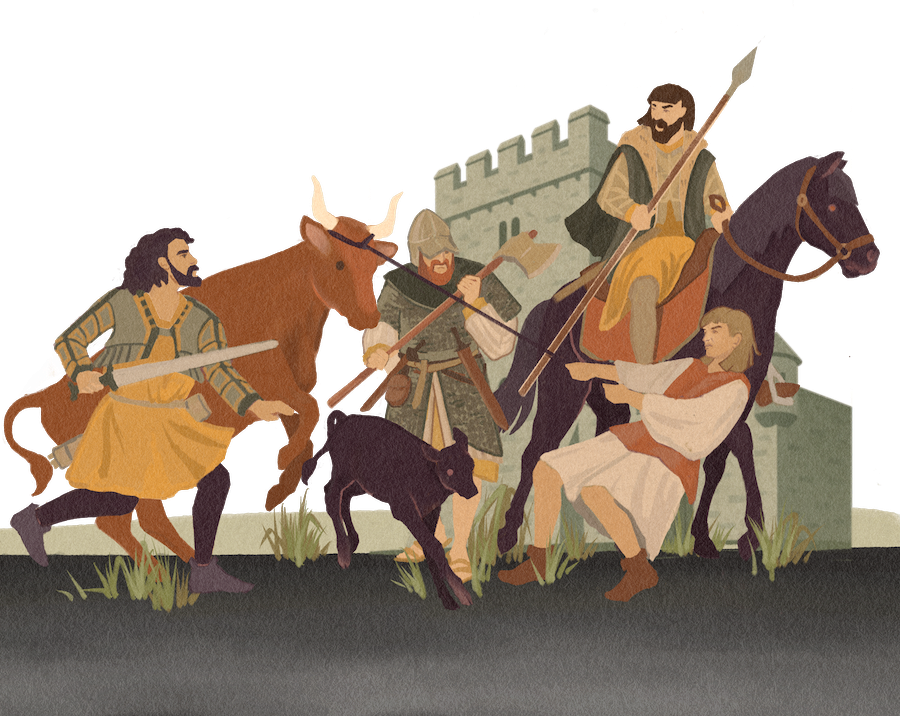
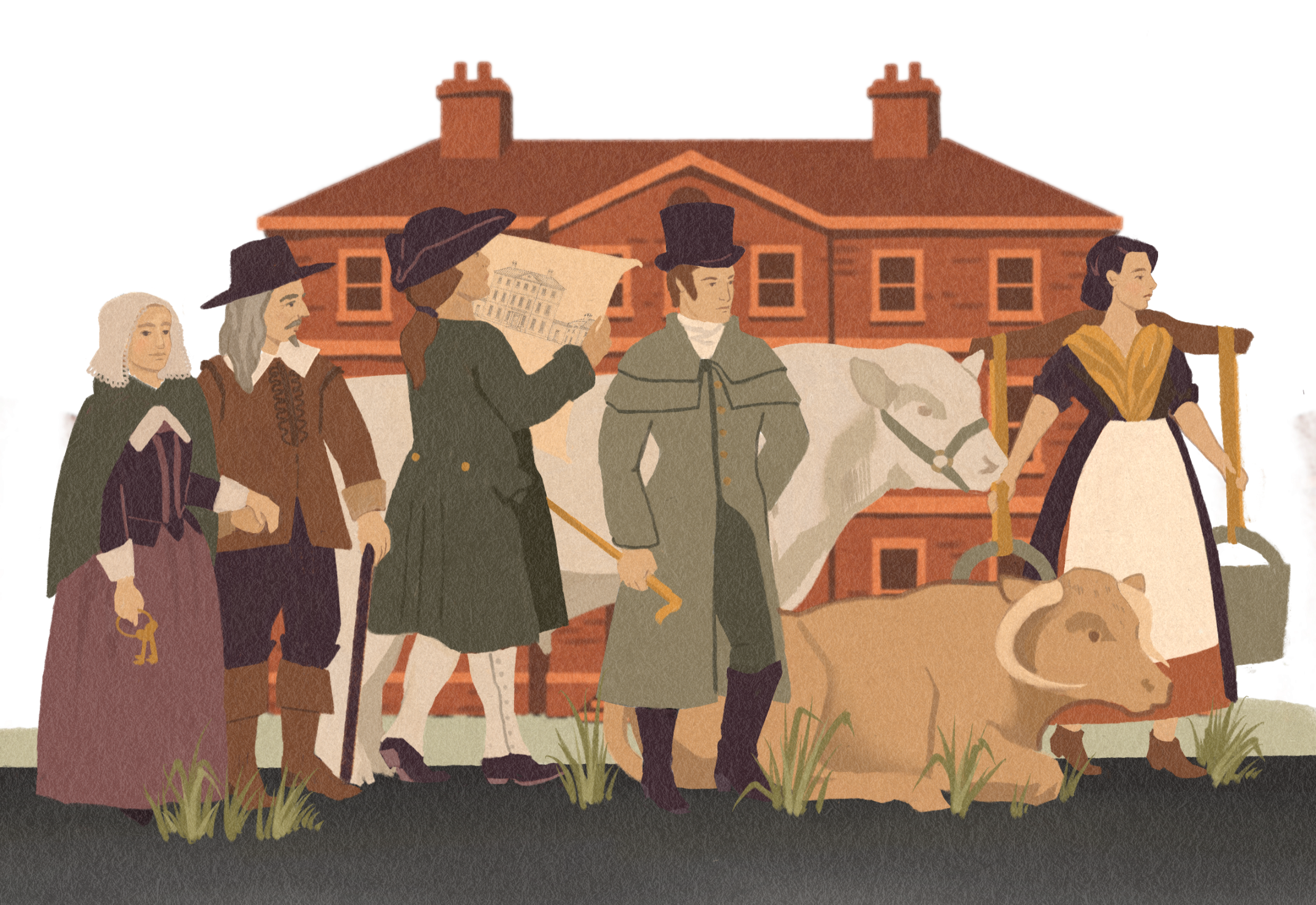
Frenchpark - The Barons de Freyne
17th to 19th Century
The French family arrived in the middle of the 17th century. A merchant family from Galway, the first member associated with the area was Patrick French, who appears to have quickly built the first iteration of Frenchpark House in Dún Gar by 1667. That same year, Dominick French received over 5000 acres. These grants where given to those who displayed loyalty to the monarchy, making it easy to displace Gaelic clans from their ancestral seats of power. From their new seat—soon renamed Frenchpark—they developed the surrounding rich pasture into one of Roscommon’s great grazing estates. Over generations they invested in stock improvement, preserving one of the last herds of ancient Irish longhorns while also importing prize Shorthorns from England. Their herds, both traditional and modern, became a mark of quality in the west of Ireland.This focus on cattle was matched by an eye for commerce. The Frenches built the infrastructure of a market town—supporting road improvement, adding a market house, and encouraging regular fairs. By the 1830s, Frenchpark’s Thursday market was famous for its butter, drawing merchants from Sligo and beyond to buy firkins for export. Pigs, yarn, and other goods filled the stalls, but it was cattle and dairy that set the pace of trade.Through the eighteenth and early nineteenth centuries, each successive head of the family took an active role in politics, most often representing Roscommon as Whig Party MPs in the Irish or later the United Kingdom Parliament. They cultivated an image as advocates for Irish interests—at times declining honours that came with political conditions they opposed, including the Act of Union. This tradition of political engagement tied the French name as much to the debating chamber as to the cattle fair. Nearly two centuries would pass before they gained a title—Arthur French was created Baron de Freyne in 1839—just on the eve of the Great Famine, when the fortunes of the estate and the fate of its tenants would come under unprecedented strain.
Artist’s Notes:
This panel marks the arrival of the French family in Frenchpark. On the far left stand Patrick French and his wife. She holds the keys to their new home—seen rising behind them in its earliest form—symbolising the family’s settlement and authority. Their clothing reflects the sober style of wealthy Galway merchant families, strongly influenced by Puritan, English, and Continental fashions.To their right appears an architect of the 1730s, distinguished by his tricorne hat. While no definitive record survives, it is very possible that the celebrated architect Richard Cassels was involved in the later expansion of Frenchpark House, whose form strongly echoes his other great works of the period, such as Strokestown Park House.Beside him is Arthur French, 1st Baron de Freyne, shown in his role as agricultural improver. He was instrumental in the importation of massive English bulls to enhance local cattle stock, while also preserving one of the last known herds of the Irish Longhorn (often called the Connaught Ox). This distinctive native breed was famous for its unusual horns—sometimes curling down beneath the jaw, arching above the nose, or even growing inward toward the cheeks. Here, the Longhorns are shown lying down, a symbolic gesture to their decline and eventual extinction.Finally, on the far right, a tenant milkmaid represents the productivity of the estate and the enormous quantities of butter exported in firkins from this district through the port of Sligo.
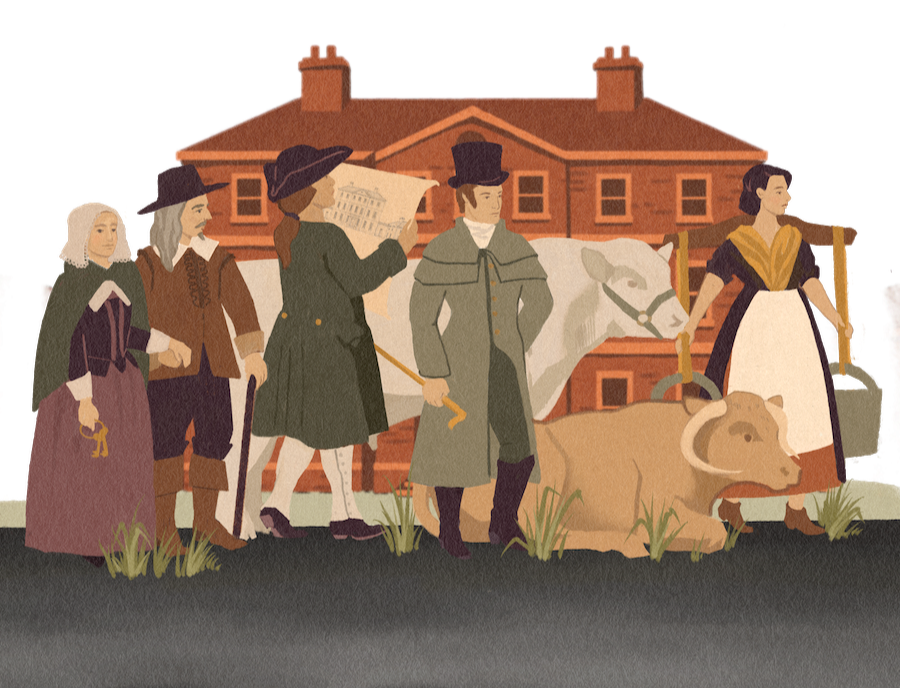
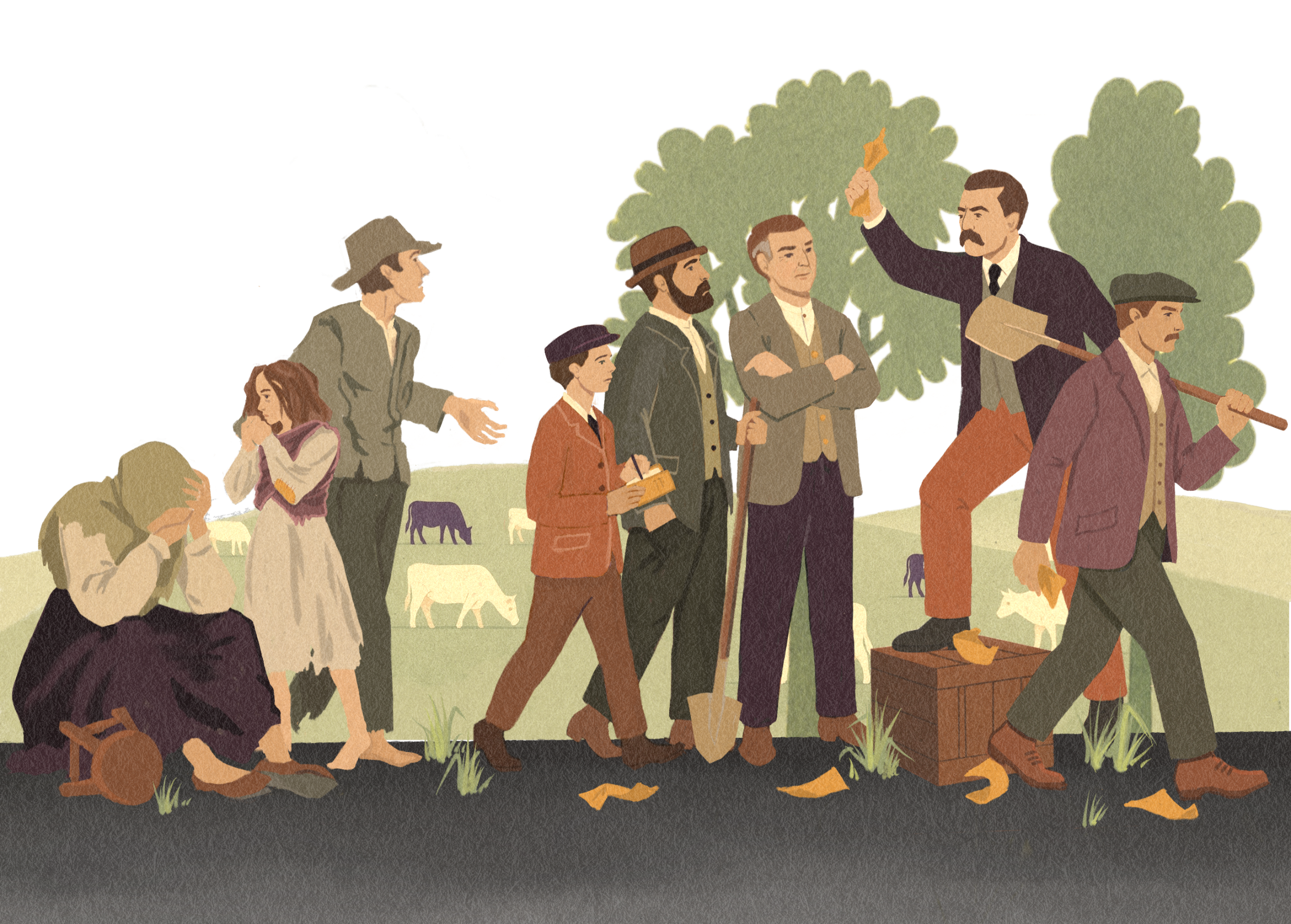
Famine, Land Wars, & Defiance
1846 to 1900
In the 1840s, the Great Famine brought hunger and fever to Frenchpark, leaving families weakened and entire townlands in distress. One local agent wrote of seeing people return home “in tears…without a particle of food,” their households on the brink of ruin. The Roscommon Journal praised the Baron de Freyne for using his own resources to support tenants, employing over a thousand people daily on estate works, distributing blankets, and avoiding large-scale evictions — “an example all landlords should follow.”Not all landowners acted with such restraint during the famine. Absentee proprietor William Murphy of Dublin — a prominent cattle dealer who had acquired land here — evicted some 270 people from his Frenchpark holdings, demolishing dozens of homes and leaving their occupants destitute. Such stark contrasts in landlord responses weakened long-standing bonds between tenants and landowners, replacing them with mistrust.In the decades that followed, the economics of farming shifted. Grain tillage, already in collapse during the famine, never recovered; falling prices and labour shortages made cattle grazing far more profitable for landlords. Across the estate, fertile lowlands were cleared of smallholders and converted to enclosed pasture, while many evicted families were pushed onto poorer bog plots. From the edge of the demesne, tenants could see miles of rich grass reserved for livestock — a daily reminder of their exclusion.By the late 19th century, organised resistance was taking root. The Land League brought mass meetings to the district, with rallies broken up by police, and prosecutions like the 1887 trial of David Sheehy at Frenchpark courthouse making headlines. One of the most active organisers of the Plan of Campaign — “next only to John Dillon and William O’Brien,” as one biographer put it — Sheehy’s presence here tied Frenchpark directly to the national stage of the Land War. Its fields became both a workplace and a battleground, the contrast between green pasture for cattle and bogland for people a potent symbol of injustice.
Artist’s Notes:
This panel was one of the most difficult to create—depicting the Famine is no easy task. On the left, a mother returns home with empty hands, their child clinging to her father. The father gestures helplessly toward the lush, fattened cattle in the fields—animals raised for export while the poor went hungry. For many, the right to keep even a single cow was stripped away, as famine hastened the shift to commercialised cattle and left the lower classes with no means of survival.A small gap follows, marking the passage of time. The next figures are a young Douglas Hyde of the 1870s, shadowing local farmers to learn Irish. He is discussed in the next panel, but he is depicted here to stay consistent chronologically. Beside him is a local tenant—perhaps an everyday farmer, or perhaps Séamus Hart, the Fenian gamekeeper and Hyde’s mentor. Hart shared myths, fables, and folklore with Hyde, shaping a passion that would influence both his life and Ireland’s cultural revival.They arrive at a gathering in the woods. On the box stands David Sheehy, pamphlet in hand, addressing tenants in defiance of the law. His rally in Frenchpark was broken up by police, then reformed outside town, leading to his trial and imprisonment. Hyde, though never partisan, witnessed such events and quietly supported land reform and the belief that every Irishman had a right to make a living off their own land.At the far right, a tenant steps forward into the closing years of the 19th century, land war pamphlet in hand and more billowing along the ground to represent a growing movement, his stance marked by deepening frustration—and the restless stirrings of change.
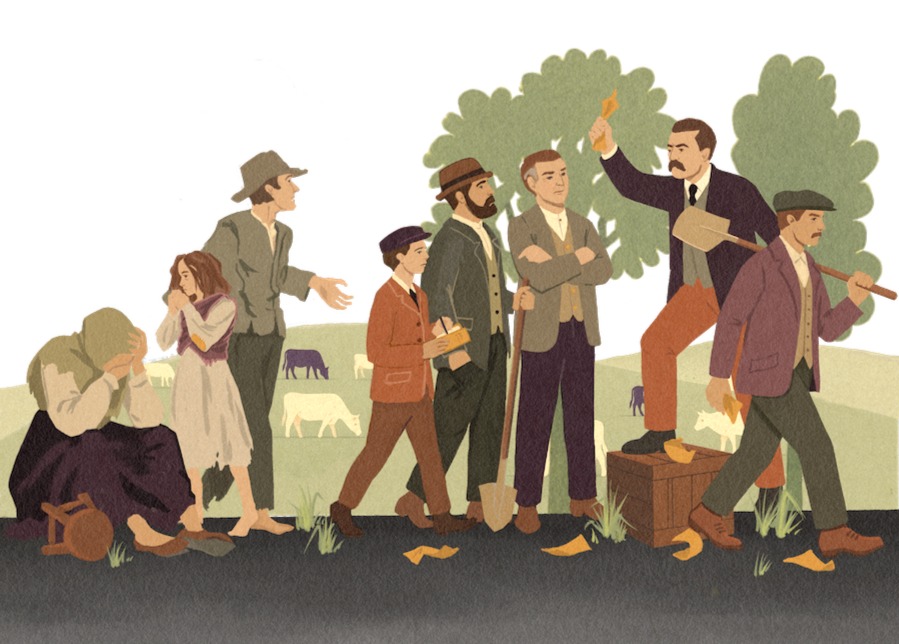
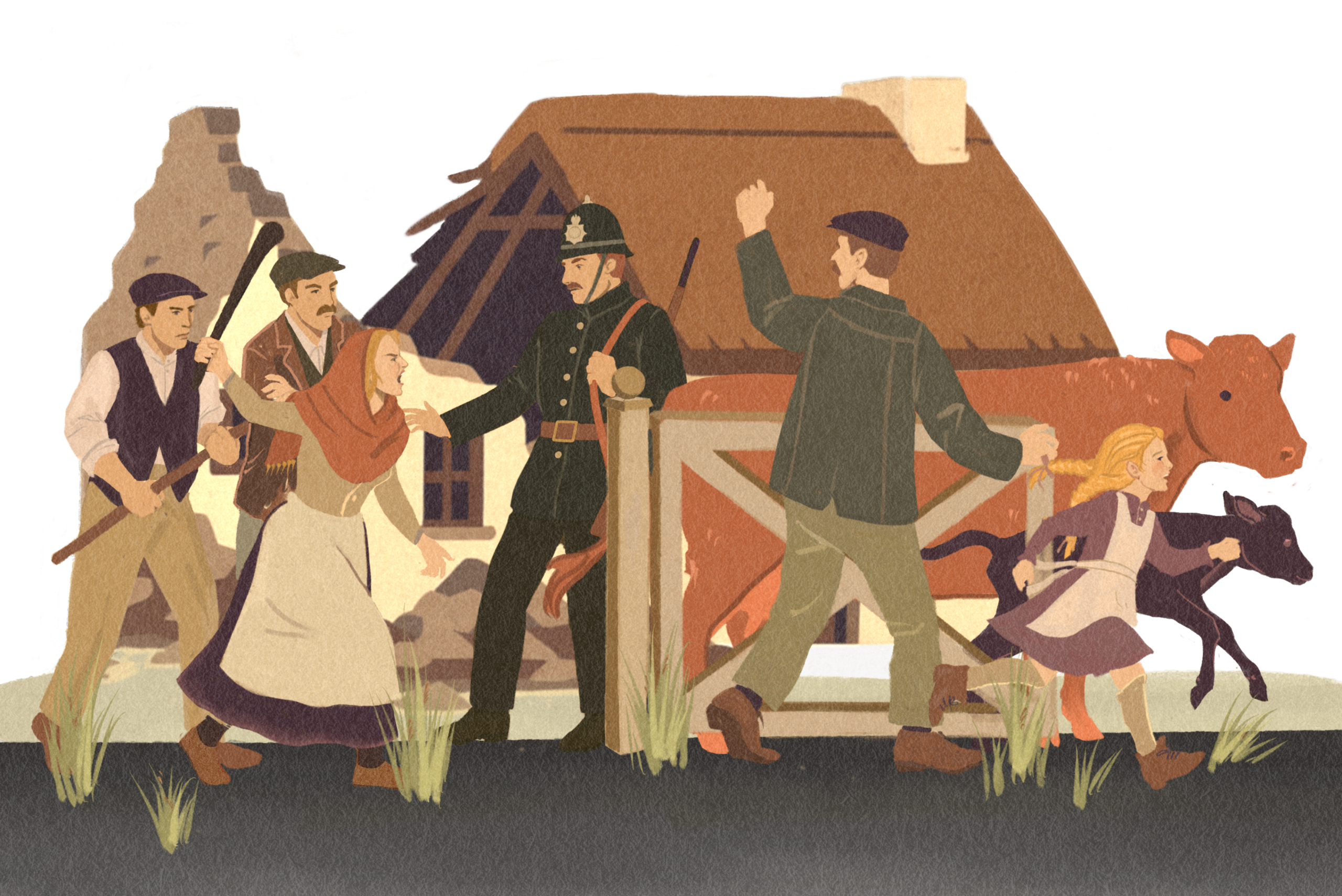
Frenchpark: Towards a Modern Ireland
1867 - 1920
In the decades after the famine, a boy who would help shape the cultural soul of a new nation grew up in Frenchpark. First President of Ireland Douglas Hyde, born in 1860 at Castlerea, moved with his family to Frenchpark in 1867 when his father became rector of Tibohine parish. At a time when Irish was deeply unfashionable, he learned it from the locals — most memorably from Lord de Freyne’s gamekeeper, Séamus Hart, a passionate Fenian and skilled storyteller. Roaming lanes and fields, sometimes following farmers with their cattle, he absorbed rare words, turns of phrase, and folklore that shaped his scholarship.Hyde co-founded the Gaelic League in 1893, and in 1909 became the first Professor of Modern Irish at University College Dublin. His mission to revive the language and culture became a cornerstone of the new Irish state — a vision deeply rooted in his Frenchpark upbringing.By 1901, another Frenchpark story was shaping the nation. Approximately 700 holdings on the massive de Freyne estate, denied rent reductions and purchase terms offered elsewhere, withheld rent. Organised by the United Irish League, the strike brought eviction orders, police escorts, barricades, stone-throwing, and a unified front of tenants past breaking point. Women played a pivotal role, often resisting while men were away working — barring doors, carrying boiling water, and physically blocking bailiffs from destroying cottages.The dispute became one of the most visible challenges to landlord power in Ireland, with press coverage going international, helping to push through the Wyndham Land Act of 1903. By 1906–07, over 36,000 acres had been purchased by the Congested Districts Board for redistribution, breaking up grazing ranches and returning prime pasture to local farmers. Bonfires lit the hills to celebrate the end of landlordism in Frenchpark, unknowing in their triumph that a second pillar of modern Ireland was born.
Artist’s Notes:
This final panel depicts the closing chapter of landlordism. On the left, a trio of tenants stand close together in solidarity, echoing the mass refusal to pay rent that gripped the De Freyne estate for over a year. The woman and constable are drawn from an extant 1902 sketch, which captured the fierce role women played in defending their homes during eviction attempts. She grips a shillelagh, unflinching in her determination, while the constable hesitates before her defiance.The era was marked by tense conflict: tenants hurled stones, scalding water, and in some cases even bricked themselves inside to resist eviction. Contemporary accounts from constables and land agents reveal both frustration and moral conflict—many recognised that eviction was futile, yet duty bound them to carry it out. Here, the constable does not draw his weapon and backs away, his posture signalling a battle the tenants were winning.At the edge of the gate, a victorious tenant holds it open as cattle stride forward, a playful calf running free and a child racing alongside in celebration. This moment represents the passing of the old order and the first steps into a new era of equality. In the background, a cottage stands half-ruined, half-intact—the fallen side a reminder of decades of hardship, the sound side a symbol of renewal and a new Ireland.
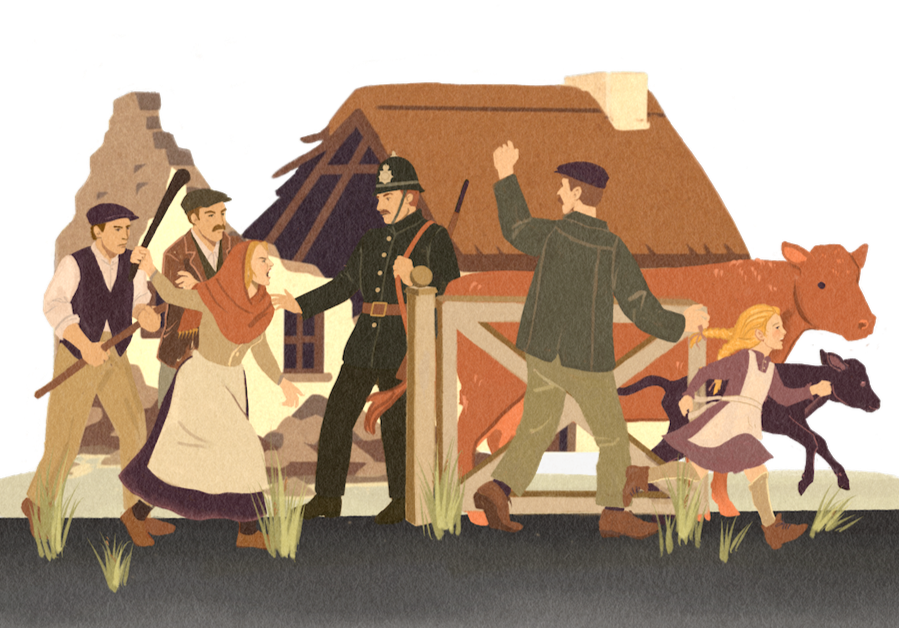
Frenchpark Today
Frenchpark, in all its spirit, has contributed to the nation in more ways than one. It nurtured the young mind of Douglas Hyde, who carried the language of his childhood into the cultural foundations of a new Irish state. It was home to men and women whose resolve against injustice helped bring about the reforms Ireland had long cried out for. In many ways, Frenchpark unknowingly played a foundational role in shaping modern Ireland.And yet, as the country moved forward, Frenchpark slipped quietly into the footnotes of history — seeking no credit, simply getting on with life.The early 20th-century Land Acts reshaped Frenchpark. Once the vast lands of the estate were transferred to the Congested Districts Board, the holdings began to crumble. The Frenches left, never to return. The last Baron sold the remaining lands and the family home, and when no new purpose could be found for the house, it was dismantled piece by piece and sold for materials — the same fate it had once dealt to the fort of Dún Gar in the name of progress. Today, only an old smokehouse and a few crumbling walls remain.As the estate dissolved, the demesne opened to new owners and the land was reclaimed. But time took its toll, and the great markets eventually went quiet. The town that had once been the hub of a grazing empire was left with its stories and its fields — and yet the slow procession of cattle still moves across the land, their calls tying us to a vibrant and ancient past that simmers just beneath, if only one chooses to look.The market house stands silent and empty, and the town is too often seen as a place to pass through rather than a place to stay. Outsiders may think we don’t care as our heritage slowly fades. Not only do we care — we’re doing something about it, starting here. For in all its history and heritage, we know one thing: Frenchpark is a place to stand by, to notice, and to believe in.In the very fabric of this town, a living thread runs through every story. This is our attempt to trace that line — not as a definitive history, but as a gesture of memory and care.This mural is long, because our story is long. You may have to look closely, but perhaps that is fitting: heritage often asks us to pause, to notice.Thank you for walking it with us.

The Living Thread of Dún Gar
Acknowledgements
This digital mural was created by the Frenchpark Historical Society in early collaboration with Frenchpark Tidy Towns. It is supported by Roscommon County Council.
We are grateful to the Heritage Council of Ireland for including this project in Heritage Week 2025.
And to our neighbours, supporters, and everyone who are following the Living Thread — thank you.
References & Further Reading
This project was prepared with care, drawing on the best available sources. Any errors are unintentional, and we welcome additional information or corrections from those with knowledge to share.
1. Airtech: Life, Legend & Legacy
Courtney Deery Heritage Consultancy Ltd. (2023) “Chapter 14: Archaeology & Cultural Heritage.” Environmental Impact Assessment Report, N5 Ballaghaderreen–Scramoge Road Project. Roscommon County Council.
MacCotter, Paul. (2008) Medieval Ireland: Territorial, Political and Economic Divisions. Dublin: Four Courts Press. ISBN 1-84682-098-7.
Hogan, Edmund, Onomasticon Goedelicum: locorum et tribuum Hiberniae et Scotiae; an index, with identifications, to the Gaelic names of places and tribes (London and Dublin: Hodges, Figgis & Co., 1910), s.v. ‘Airtech’, Locus Project (University College Cork) https://research.ucc.ie/doi/locus/A.html [Accessed 12 August 2025].
Lewis, S. (1837) A Topographical Dictionary of Ireland, vol. 1. London: S. Lewis & Co., p. 635.
Kelly, F. (1988) A Guide to Early Irish Law. Dublin: Dublin Institute for Advanced Studies.
Urbanus, J. (2021) ‘An Irish Idol’, Archaeology, November/December. Available at: https://www.archaeology.org/issues/446-2111/digs/10101-digs-ireland-idol (Accessed: 12 August 2025).
Rathcroghan: Where History Comes to Life. Heritage Ireland. Available at: https://www.rathcroghan.ie/ (Accessed: 12 August 2025).
2. Saints & Scholars: Early Christianity
Colgan, John. (1948) Acta Sanctorum Hiberniae. Leuven 1645; repr. Dublin: Stationery Office, p. 358.
Sharpe, Richard. (1991) Medieval Irish Saints' Lives: An Introduction to Vitae Sanctorum Hiberniae. Oxford: Clarendon Press.
National Folklore Collection (Dúchas), Dún Gar (Frenchpark), (1938). "The Hermit’s Cow"
Cloonshanville – Head2. [3D model]. Sketchfab, 2025. Available at: https://sketchfab.com/3d-models/cloonshanville--head2-554bf0bd8ec64df59e1d1b47d9d73a3d (Accessed: 13 August 2025).
“Biatach.” In An Etymological Dictionary of the Gaelic Language. Revised edition, ed. Alexander MacBain. UCC: Old Irish Lexicon
2. Further Source Lists Forthcoming
Artwork © Natalie Folan, 2025
